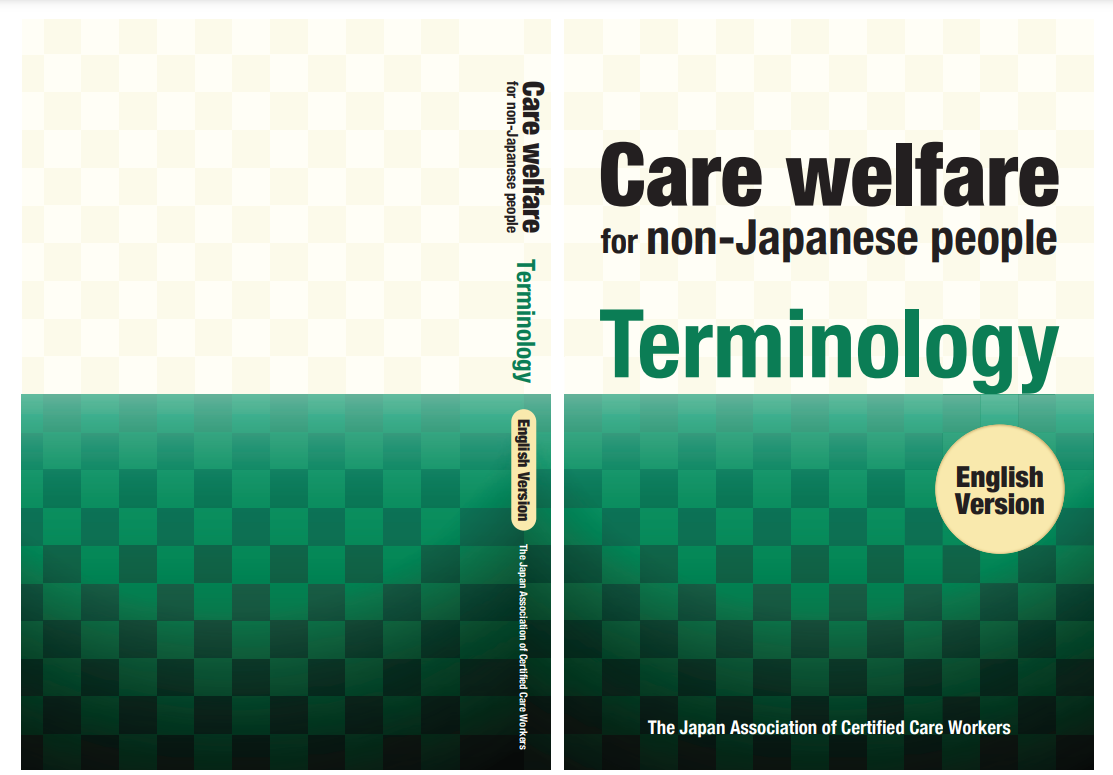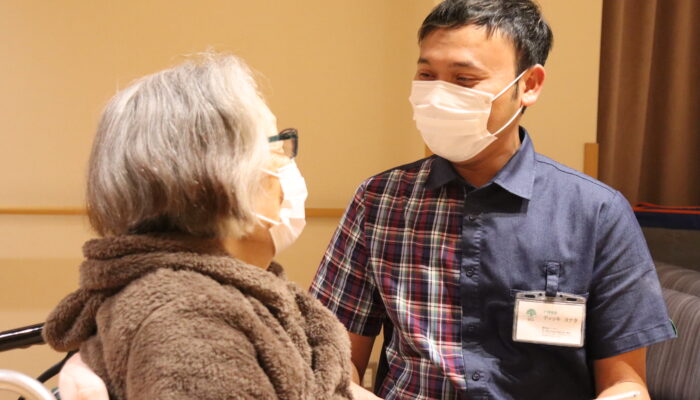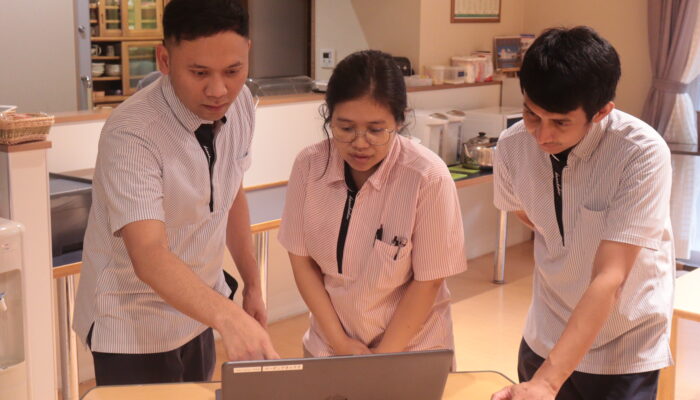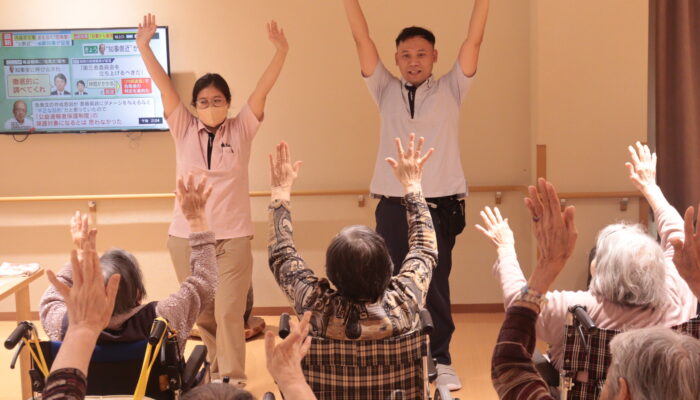
There are some commonly used phrases and specialized terms that can be found in care workers’ workplaces, such as in conversations with fellow care personnel, or in our users’ records. It is extremely important to know specialized terms in order to be aware of patients’ physical condition and to work together with fellow care workers. It may be difficult at first, but try to remember these phrases and specialized terms.
Contents:
Phrases used with fellow personnel
- 「バイタルチェック」(VITAL CHECK)(Vital check)
Refers to the measurement of vital signs (temperature, blood pressure, breathing, pulse). Patients’ vital signs are measured every morning before they take baths so that all members of staff can understand their physical condition.
Example: 「○さんの朝のバイタルは正常です、いつもと変わりありません」
(○さんのあさのばいたるはせいじょうです、いつもとかわりありません)
(○ san no baitaru wa seijyo desu, itsumo to kawari arimasen)
(Mr./Ms. ○’s vitals are normal, there are no changes from his/her usual vitals.)
- 「見守り」(みまもり)(MIMAMORI)(Watching over)
Refers to understanding things such as the circumstances and feelings of individual patients, and immediately assisting them whenever necessary, while allowing them to do things they can do on their own.
This also includes keeping an eye on patients to prevent falls and accidents from happening.
Example: 「○さんは、歩くときにふらつくことがあるので、見守りをしましょう」
(○さんは、あるくときにふらつくことがあるので、みまもりしましょう)
(○ san wa, aruku toki ni furatsuku koto ga aru no de, mimamori wo shimashou)
(○ san sometimes staggers when walking, so let’s watch over him/her)
- 「処置」(しょち)(SHOCHI)(Treatment)
Refers to treatment of injuries and bed sores by disinfecting the necessary areas and applying medicine.
Example: 「腕に傷があるので、看護師に処置をしてもらいましょう」
(うでにきずがあるので、かんごしにしょちをしてもらいましょう)
(Ude ni kizu ga aru no de, kangoshi ni shochi wo shite moraimashou)
(There is a wound on his/her arm, so let’s ask the nurse to treat it.)
Other phrases such as
「○さんは、部屋で休んでいます」
(○さんは、へやでやすんでいます)
(○ san wa, heya de yasundeimasu)
(Mr./Ms. ○ is resting in his/her room.)
「○さんは、食事を残したので、体調に気をつけてください」
(○さんは、しょくじをのこしたので、たいちょうにきをつけてください)
(○ san wa, shokuji wo nokoshita no de, taichou ni ki o tsukete kudasai)
(Mr./Ms. ○ did not finish his/her food, so please pay attention to his/her physical condition.)
「◯さんは、顔色が悪いので体調の変化に気をつけ、観察してください」
(○さんは、かおいろがわるいのでたいちょうのへんにきおつけ、かんさつしてください)
(○ san wa, kao iro ga warui no de taichou no henka ni ki o tsuke, kansatsu shite kudasai)
(Mr./Ms. ○ looks unwell, so please keep an eye on him/her and pay attention to his/her physical condition.)
are frequently used when reporting and sharing even minor changes in patients’ physical condition with fellow personnel.
Other care-related specialized terms you should remember
There may be some difficult kanji, so please try to read the following aloud.
- ケアプラン(CARE PLAN)(Care plan): Refers to plans in which the type, frequency, and objectives of the care services received by patients are recorded. These plans are created based on the kind of lifestyle that patients, and their family members, want patients to lead, and are updated on a regular basis based on patients’ condition. Care services are given based on these care plans.
- 受診(JUSHIN)(Medical consultation): Refers to a medical examination carried out by a doctor. There may be cases where doctors visit the facilities for consultations, or cases where patients travel to hospitals with personnel or family members for consultations.
- 水分補給(SUIBUN HOKYU)(Hydration): Refers to the intake of water required for the body through the consumption of food and drink. It is difficult to notice patients’ thirst, so it is necessary to regularly prompt them to hydrate.
- 体位変換(TAII HENKAN)(Changing body position): Refers to helping those who are unable to turn over on their own, or those who are unable to change their position on their own, to change their position.
Laying down in the same position for too long will cause worsened blood circulation and lead to the formation of bed sores.
- 着脱(CHAKUDATSU)(Dressing and undressing): Refers to the putting on and taking off of clothing.
- 発熱(HATSUNETSU)(Having a fever): Refers to the rise of body temperature above normal levels due to illness.
A person with a body temperature above 37.5 degrees is usually considered to have a fever, but every person has his/her own normal body temperature, so it is necessary to be attentive to changes in physical condition if a patient’s body temperature is higher than normal.
- ベッドメイキング (BED MAKING) (Bed making): Refers to the changing of sheets, futons, pillow covers, et cetera. Bed making is done regularly to maintain hygiene and patients’ quality of sleep.
- 面談 (MENDAN) (Interview): Refers to conversations between patients, their family members, and care personnel. These conversations can include subjects such as patients’ health, their daily lives, any troubles they may be having in their lives, and the lifestyle they would like to lead.
Held when patients start using care services and when patients’ care plans are modified, but are also held on a regular basis otherwise.
- 配膳 (HAIZEN) (Serving): Refers to the serving of meals. It is necessary to set out tableware in positions that allow patients to have their meals easily and comfortably.
There is a link in the Links page which introduces a glossary containing a list of terms used in care work.
Please make good use of it.
- Care welfare for non-Japanese peopleTerminology
▶English version
▶Khmer version
▶Indonesian version
▶Nepali version
▶Mongolian version
▶Burmese version
▶Vietnamese version
▶Chinese version
▶Thai version
▶Uzbek version



